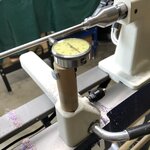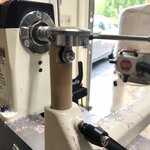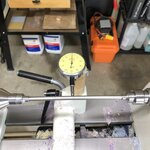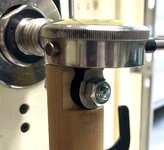Hartwell85
Member
I made a run out gauge for my lathe based on a similar product sold by a woodworking supplier. (Can't remember the suppliers name.)
It was very easy to make. The post is a 1" wood dowel that was lightly sanded to make a push fit into the banjo's tool rest hole. Next, I precisely cut a notch on the dowel to snugly mount the dial indicator securing it with a 1/4"-20 bolt and nut. The whole assembly is very solid and I only need to lightly tighten the locking lever on the tool rest post to hold the indicator at the correct height. The photos show the gauge checking run out on my Axminister pen mandrel (0.002" run out).
It was very easy to make. The post is a 1" wood dowel that was lightly sanded to make a push fit into the banjo's tool rest hole. Next, I precisely cut a notch on the dowel to snugly mount the dial indicator securing it with a 1/4"-20 bolt and nut. The whole assembly is very solid and I only need to lightly tighten the locking lever on the tool rest post to hold the indicator at the correct height. The photos show the gauge checking run out on my Axminister pen mandrel (0.002" run out).




